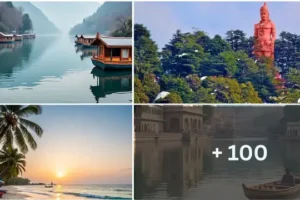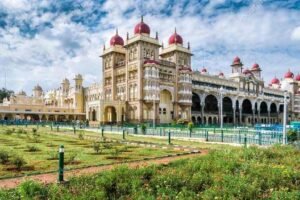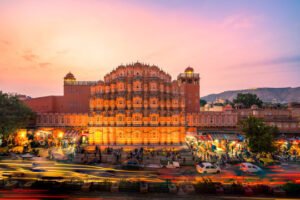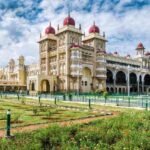The Spiritual Sanctuary: Tashi Jong Khampagar Monastery, Bheth Jhikli, Himachal Pradesh
Introduction to Tashi Jong Khampagar Monastery: The Tashi Jong Khampagar Monastery, nestled in the serene landscapes of Bheth Jhikli, Himachal Pradesh, stands as a beacon of spiritual and cultural significance. Founded in the 1960s by the 8th Khamtrul Rinpoche, this monastery has established itself as a pivotal center for the Drugpa Kagyu lineage of Tibetan Buddhism. The monastery was envisioned as a sanctuary for spiritual learning, meditation, and the preservation of Tibetan culture, reflecting the profound vision and dedication of its founder.
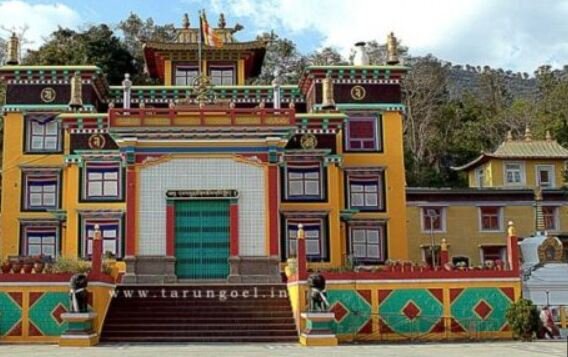
The establishment of Tashi Jong Khampagar Monastery was a response to the upheavals faced by Tibetan Buddhists during the mid-20th century. The 8th Khamtrul Rinpoche, recognizing the need for a safe haven where the teachings and traditions of the Drugpa Kagyu lineage could be safeguarded and nurtured, chose the tranquil environs of Himachal Pradesh for this spiritual endeavor. The monastery not only serves as a place of worship but also functions as a vibrant community where monks and lay practitioners engage in rigorous spiritual practices and study.
Throughout its history, Tashi Jong Khampagar Monastery has been instrumental in promoting the core principles of Tibetan Buddhism. It offers a comprehensive program of spiritual education, including teachings on meditation, philosophy, and ritual practices. The monastery’s commitment to preserving Tibetan culture is evident in its various activities aimed at maintaining traditional arts, crafts, and literature. This dedication ensures that the rich heritage of Tibetan Buddhism continues to thrive and inspire future generations.
Today, Tashi Jong Khampagar Monastery stands as a testament to the enduring legacy of the 8th Khamtrul Rinpoche and the resilience of the Tibetan Buddhist tradition. It remains a place of profound spiritual significance, attracting devotees and visitors from around the world who seek to deepen their understanding of Tibetan Buddhism and find solace in its peaceful surroundings.
Architectural and Artistic Marvels
Tashi Jong Khampagar Monastery stands as an epitome of traditional Tibetan architectural brilliance, skillfully harmonizing spirituality and artistry. The monastery’s design is a testament to the meticulous craftsmanship and profound spiritual symbolism inherent in Tibetan culture. The structure boasts intricate woodwork, evident in the beautifully carved window frames and doors that welcome visitors into the sacred space.
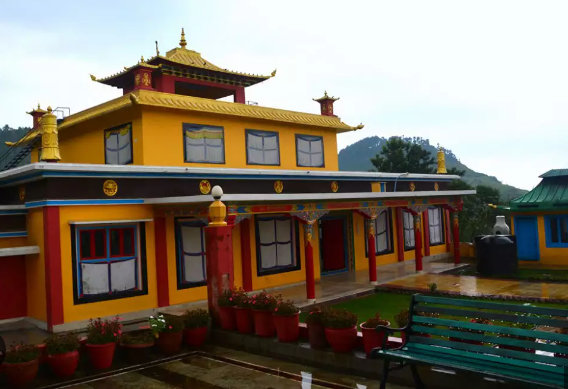
The main prayer hall, a focal point of the monastery, is adorned with vibrant murals that depict various deities and significant events from Buddhist lore. These murals are not merely decorative but serve as visual narratives that convey teachings and stories, enriching the spiritual experience for devotees and visitors alike. The hall houses statues of revered deities, each crafted with precision and imbued with deep religious significance. These statues, often gilded and adorned with precious stones, are central to the monastery’s spiritual activities.
Thangka paintings, another prominent feature of Tashi Jong Khampagar Monastery, grace the walls with their intricate designs and vivid colors. These traditional Tibetan scroll paintings are rich in detail and symbolism, often portraying deities, mandalas, and other spiritual motifs. Thangkas are not only artistic masterpieces but also serve as meditation aids, helping practitioners focus on the depicted deities and their attributes.
The stupas scattered around the monastery grounds are further testament to the architectural and spiritual grandeur of Tashi Jong. These dome-shaped structures, often containing relics, are venerated as symbols of the enlightened mind. Each stupa is intricately decorated, reflecting the devotion and skill of the artisans involved in their creation.
Notable craftsmen and artists have contributed to the monastery’s artistic heritage. Their dedication and expertise are evident in the meticulous detailing and vibrant palette of the artworks. The harmonious blend of architecture and art at Tashi Jong Khampagar Monastery not only enhances its visual appeal but also creates a profound spiritual ambiance, inviting visitors to immerse themselves in the tranquil and sacred atmosphere of this Himalayan sanctuary.
Life and Practices at the Monastery
Tashi Jong Khampagar Monastery, nestled in the serene locale of Bheth Jhikli, Himachal Pradesh, is not only a place of worship but also a thriving center of monastic life and spiritual discipline. The daily life of the monks is meticulously structured, beginning early in the morning with meditation practices that serve as the cornerstone of their spiritual journey. These meditation sessions, often held in the tranquil ambiance of the monastery’s prayer halls, are vital for cultivating mindfulness and inner peace.
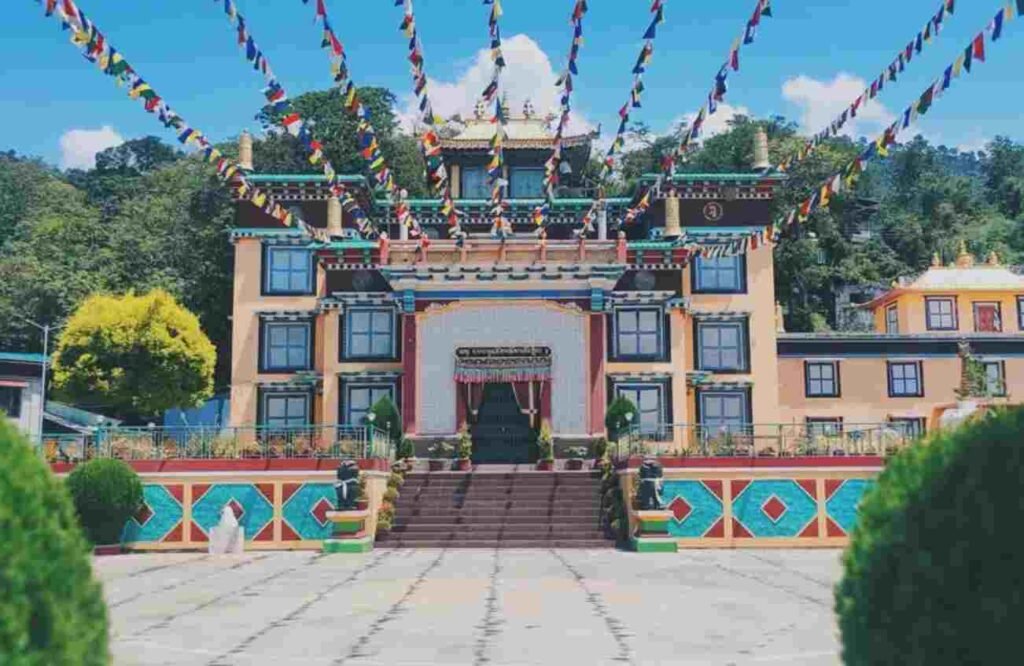
Following meditation, the monks engage in a series of prayer sessions, reciting sacred mantras and Buddhist scriptures. These prayers are not just ritualistic chants but are deeply rooted in the teachings of Tibetan Buddhism, aimed at fostering compassion, wisdom, and understanding. The study of Buddhist scriptures forms a significant part of the monks’ daily routine. Under the guidance of senior monks and teachers, they delve into texts that span centuries of Buddhist thought, philosophy, and practice, ensuring the preservation and continuation of their rich spiritual heritage.
The monastery is also a hub of various ceremonies and rituals that are integral to Tibetan Buddhist practice. One of the most notable events is the annual Cham Dance festival. This vibrant and colorful festival features monks performing masked dances that symbolize the triumph of good over evil. The Cham Dance is not merely a spectacle but a profound spiritual practice that invokes blessings and protection for the community. Such ceremonies are essential in reinforcing the cultural and spiritual bonds within the monastic community and with the lay followers who participate in these events.
The disciplined routine and spiritual practices at Tashi Jong Khampagar Monastery play a crucial role in maintaining the spiritual discipline and communal harmony among the monks. They embody the principles of Tibetan Buddhism, fostering a life of simplicity, devotion, and continuous learning. The monastery, thus, stands as a beacon of spiritual solace and cultural preservation in the region.
Visitor Experience and Community Engagement
Visiting Tashi Jong Khampagar Monastery provides an enriching experience steeped in spirituality and cultural heritage. Nestled in the serene village of Bheth Jhikli in Himachal Pradesh, the monastery is accessible via well-connected roadways. Travelers can reach the monastery from major cities like Dharamshala and Palampur through local buses or private taxis. The months from March to June and September to November are ideal for visiting, as the weather is pleasant and conducive to spiritual reflection.
The Tashi Jong Khampagar Monastery offers a range of facilities designed to cater to tourists. Upon arrival, visitors are greeted by a tranquil environment, accentuated by the sound of monks chanting and the sight of prayer flags fluttering in the breeze. The main prayer hall, adorned with intricate murals and statues, serves as the focal point for meditation and religious ceremonies. For those interested in deeper spiritual engagement, the monastery offers meditation retreats and guided tours that provide insights into Buddhist practices and beliefs.
Tashi Jong Khampagar Monastery is not just a place of worship but also a hub of community engagement. The monastery actively participates in educational programs, offering workshops on Tibetan Buddhism, meditation, and traditional arts. These programs are open to the public and aim to foster a deeper understanding of the cultural and spiritual dimensions of the monastery. Additionally, the monastery hosts cultural events and festivals that showcase traditional music, dance, and crafts, further enriching the visitor experience.
Accommodations are available for those wishing to extend their stay. The Tashi Jong Khampagar Monastery maintains guesthouses that offer comfortable lodging for visitors. These guesthouses provide an opportunity to immerse oneself fully in the serene and contemplative atmosphere of the monastery. For those seeking a more immersive experience, the monastery also offers meditation retreats, allowing visitors to engage in extended periods of meditation and reflection under the guidance of experienced monks.
Overall, Tashi Jong Khampagar Monastery offers a unique opportunity for visitors to explore the spiritual and cultural richness of Tibetan Buddhism. The combination of serene surroundings, educational programs, and community engagement initiatives creates a holistic experience that leaves a lasting impression on all who visit.
Important things to know about Monastery
Some additional details about the monastery:
- Location: Tashi Jong village, Kangra district, Himachal Pradesh, India.
- Founded by: 8th Khamtrul Rinpoche, Dongyu Nyima (1969)
- Tradition: Drukpa Kagyu
- Activities: Monks residing at the monastery perform daily prayers and pujas. The monastery also serves as a learning center with a Shedra (academic center), Tsokdra (ritual center), and a Drupdra (retreat center).
If you are planning to visit Tashi Jong Monastery, here are some things to keep in mind:
- Opening hours: The monastery is generally open to the public from 8:00 AM to 12:00 PM. It’s always a good idea to check their website or social media for any updates on hours.
- Dress code: As with most religious places, dressing modestly is recommended.
- Photography: Photography may be restricted in certain areas of the monastery. It is always best to ask permission before taking photos.
- Respectful behavior: Remember that this is a place of worship. Be respectful of the monks and other visitors.
How to Reach
There are generally two main ways to reach Tashi Jong Khampagar Monastery:
- By Air: The nearest airport to Tashi Jong Monastery is Gaggal Airport in Dharamshala, located approximately 80 kilometers away. From Dharamshala, you can take a taxi or bus to Palampur, the nearest major town to the monastery (around 30 kilometers).
- By Road: Palampur is well-connected by road to other major cities in Himachal Pradesh and North India. Once in Palampur, you can hire a taxi or take a local bus to reach Tashi Jong Monastery, which is about 14 kilometers away.
Here are some additional tips for reaching Tashi Jong Khampagar Monastery:
- If you are coming from Delhi, you can take a direct bus to Palampur. The journey takes approximately 10-12 hours.
- You can also hire a car from Delhi or Dharamshala to reach the monastery directly.
- The roads leading to the monastery can be narrow and winding, so be prepared for a scenic but potentially slow drive.
What is the history of Tashi Jong Monastery?
Founded in the 1960s by the 8th Khamtrul Rinpoche, this monastery has established itself as a pivotal center for the Drugpa Kagyu lineage of Tibetan Buddhism.
How far is Tashi Jong from Palampur?
The monastery is about 15km from Palampur located in Tashi Jong village, a small rural area between Paprola and Taragarh.
Is there a toy train in Palmpur?
One of the most popular attractions in Palampur is experiencing a toy train ride which is also designated as the UNESCO World Heritage Site. The train commutes between Palampur and Pathankot and takes you on a hilly ride amidst lush green forests, shimmering waterfalls and across meandering rivers.
What is the history of Tashi?
Tashi Lhunpo Monastery is the seat of the successive lineage of the Panchen Lamas. This monastery was founded by His Holiness the 1st Dalai Lama Gyalwa Gedun Drup in year 1447. It was one of the largest and greatest monasteries in Tsang province in Tibet.
Is Tashi a Tibetan Name?
Of Russian origin and feminine, it means “good fortune” in Tibetan or “auspiciousness.” It is also derived from the name Natasha and is thought to mean “born on Christmas,” perfect for holiday babies!
Which is the Himachal Oldest Monastery?
Tabo Monastery (or Tabo Chos-Khor Monastery) was founded in 996 AD (and refurbished in 1042 AD) by Rinchen Zangpo; it is considered the oldest monastery in Himachal Pradesh.
